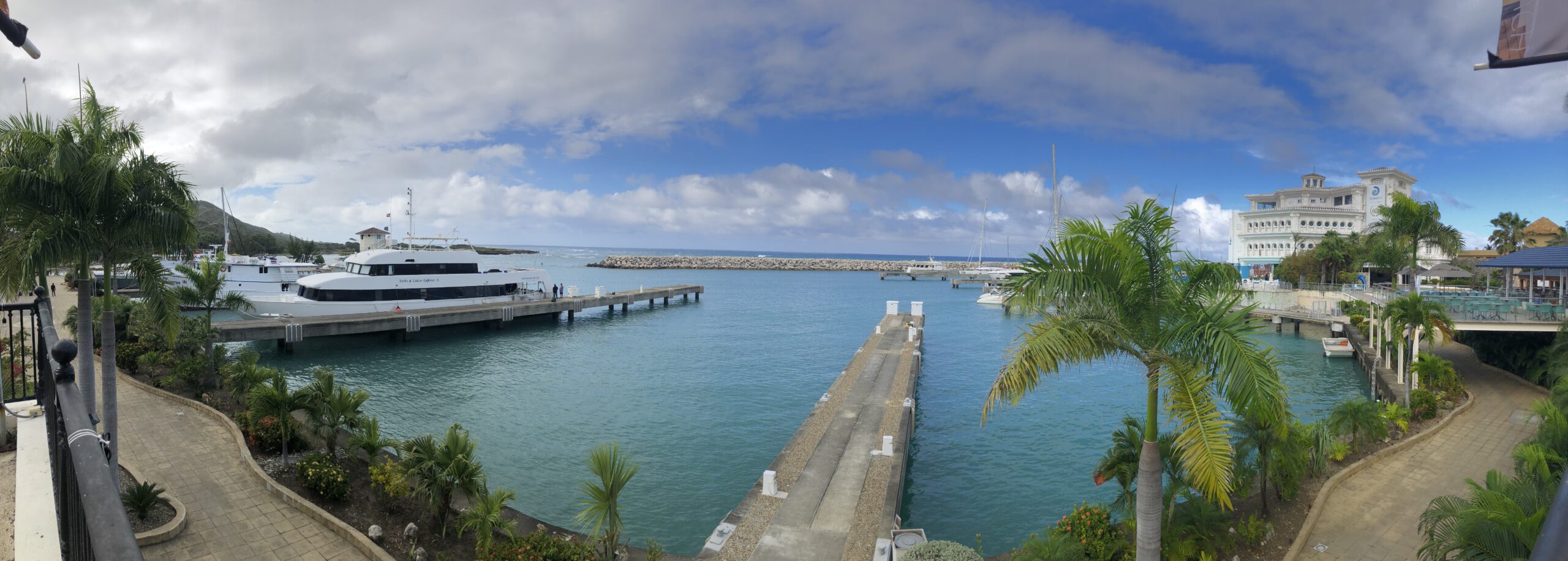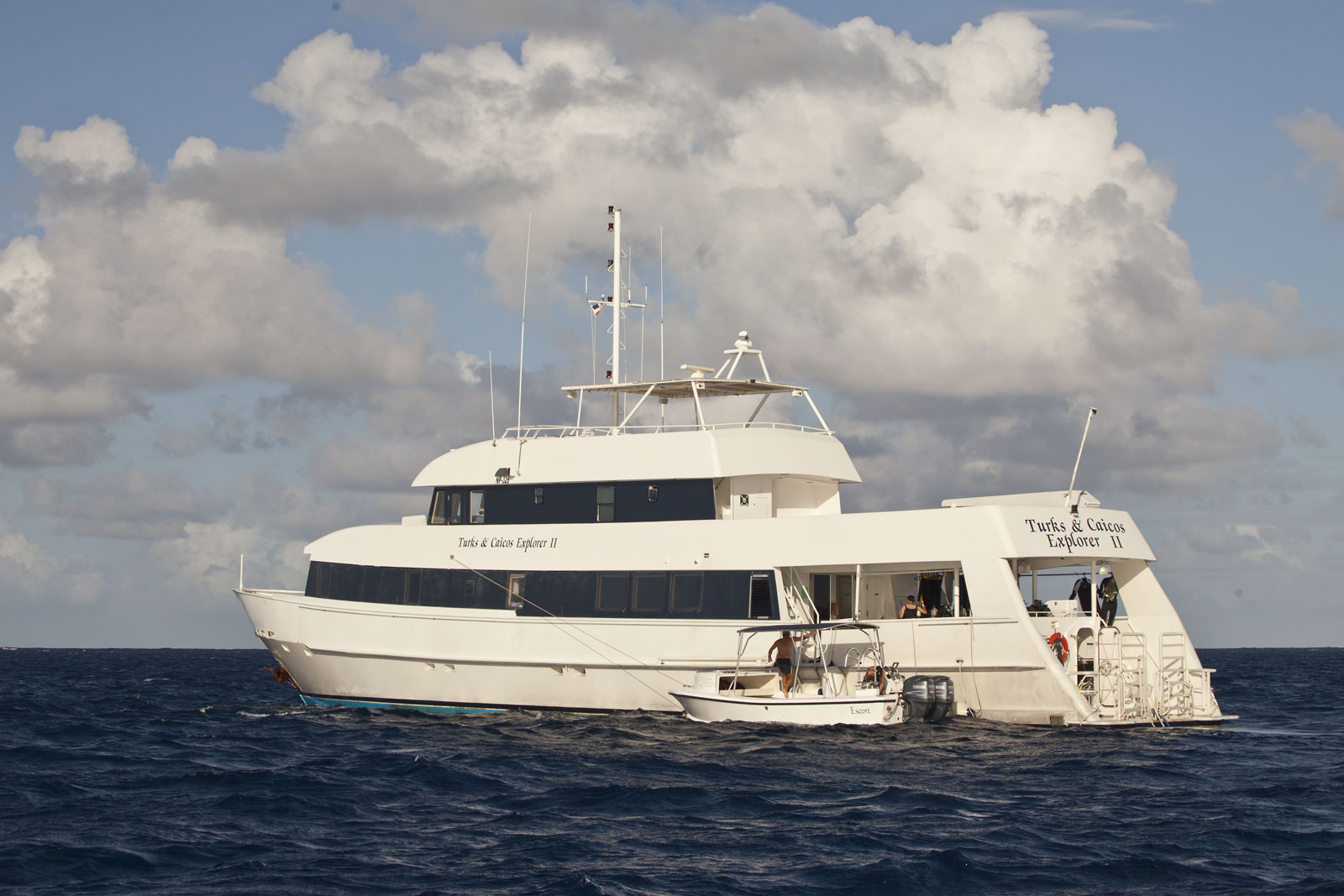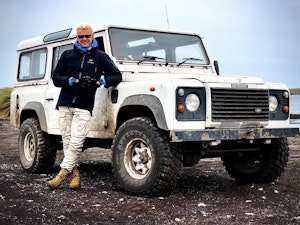Arrive in Puerto Plata, Dominican Republic
Mar 13
Arrive in Puerto Plata, Dominican Republic for an overnight stay near the Ocean World Marina.
In the warm waters off the coast of the Dominican Republic, the world’s largest concentration of humpback whales gathers on the Silver Bank to mate and calve. During this peak breeding season, you’ll have the rare opportunity to observe extraordinary whale behavior both in and out of the water. Watch from the tenders as powerful males vie for the coveted “escort” role in thrilling heat runs and slip into the water to witness playful calves trailing their mothers, learning to nurse, socialize, and explore, all while listening for the sounds of distant whale songs. With favorable weather—common this time of year—you’ll capture stunning close-up photos of breaching, flipper-slapping, and other dramatic surface displays. Revel in the soft in-water encounters where you might even find yourself eye-to-eye with these gentle giants. There’s nothing quite like sharing the water with these magnificent creatures!
⭐⭐⭐⭐⭐ “I have already recommended Cheesemans’! I loved how you care for the environment, for the animals and people you take us to visit with and for me and my fellow travelers. That caring shows up in all ways from the tiniest details in the preparation packs to the broadest decisions about the trips you offer. And most of all, it shows up in the caring, curiosity and humor of our guide.” – Elspeth Chasser |
Itinerary Updated: September 2024

| Date | Description | Lodge | Meals |
|---|---|---|---|
| Mar 13 | Arrive in Puerto Plata, Dominican Republic. | Cofresi Hills Residence, Cofresi | |
| Mar 14 | Board the ship in the evening and navigate to the Silver Bank overnight. | On board the Turks and Caicos Explorer II | B, D |
| Mar 15 | Afternoon of in-water, up-close whale interaction. | On board the Turks and Caicos Explorer II | B, L, D |
| Mar 16-19 | Enter the whales’ world during four full days of soft in-water encounters. Learn about whale behavior, anatomy, conservation, and individual personalities. | On board the Turks and Caicos Explorer II | B, L, D |
| Mar 20 | Morning of in-water whale encounters. Whale watching en route back to Puerto Plata. | On board the Turks and Caicos Explorer II | B, L, D |
| Mar 21 | Disembark after breakfast and fly home. | B |
Scott, co-owner and co-CEO of Cheesemans’ Ecology Safaris, is an expert wildlife, nature, and travel photographer. Trained as a wildlife and marine biologist, he's explored all seven continents for research and photography. National Geographic, BBC, Animal Planet, NY Times, and other prestigious publications have featured his inspiring work. Scott's passion for teaching and talent for capturing the essence of his subjects make him a highly sought-after tour leader.
Arrive in Puerto Plata, Dominican Republic for an overnight stay near the Ocean World Marina.

Arrive at the marina in the early evening to board the Turks and Caicos Explorer II. After dinner, you'll navigate to the mooring site while you spend the night in your comfortable cabin.
Wake up on the Silver Bank! After breakfast, you’ll be briefed about soft in-water encounters, a profound experience for all, and prepare for a full afternoon on the two tenders.

The numerous female humpback whales that choose the Silver Bank as their nursery for their newborn calves are usually nestled in the northeast corner of the Silver Bank, a relatively shallow area protected by coral heads. Although coral heads encompass the entire Silver Bank, the northeast corner has extensive coral that breaks the surface during low tides, giving protection to newborn calves (and you!).
You may have some “whale-waiting” time while looking for cooperative humpback whales, but that time is quickly forgotten when you are amid surface activity and soft in-water encounters. Most of the time you will find whale activity nearby. In fact, you will more often ask, “Which whale should we watch?” rather than, “Where are the whales?” The biggest obstacle to success is spending too much time with uncooperative whales, so be prepared to leave one group in search of more cooperative ones; be patient as you may approach many whales before finding an interested group that allows us to join them in their element and on their terms.
Spend the morning on the tenders for your last encounters, then return to the ship for lunch. Navigate back to Puerto Plata through the banks, watching for whale and dolphin activity from the deck while bidding farewell to the world of these docile creatures. You will arrive in Puerto Plata in the late evening for your last night on board.
Disembark in the morning, after breakfast, and transfer to the airport for your flights home.
The Turks and Caicos Explorer II is the top platform for whale watching adventures on the Silver Bank. At 124 feet long, this stable, ocean-ready ship provides both comfort and access for unforgettable wildlife encounters.
This vessel serves as your floating home during the trip, offering a relaxed and supportive environment for nature lovers. With two fast, maneuverable tenders on board, you can quickly reach areas where humpback whales gather and play. These tenders bring you eye-level with whales in calm, shallow waters.
Each day, the ship anchors on the reef near the Silver Bank, a sanctuary for North Atlantic humpback whales. From here, you’ll travel by tender to explore, observe, and sometimes even snorkel with these gentle giants.
The ship’s size allows for smooth sailing and ample space while keeping group sizes small and personal. This setup helps minimize waiting time and maximizes your hours in the water. Whale encounters often happen just a short ride from the anchored ship.
Back on board, you’ll enjoy comfortable cabins, warm meals, and daily briefings from experienced guides and crew. You’ll have time to relax, share stories, and review photos from the day’s close-up encounters.
The Turks and Caicos Explorer II is more than a vessel—it’s your basecamp for meaningful interaction with humpbacks in the wild. With the right combination of location, crew, and small-group access, this expedition delivers unmatched whale watching in the Caribbean.
If you dream of floating near breaching whales or hearing their haunting underwater songs, this ship brings that dream to life. It’s a once-in-a-lifetime adventure, made possible by the design and purpose of the Explorer II.

| Type | Description | Cost Per Person |
|---|---|---|
| Lower Deck | Double occupancy, twin-sized upper and lower beds, porthole window. Cabins 8, 9, and 10. | $6,650 |
| Main Deck | Double occupancy, two lower twin-sized beds, desk, chair, large windows. Cabins 3 and 4. | $6,850 |
| Main Deck | Double occupancy, one queen-sized bed or two twin-sized beds, desk, chair, large window. Cabins 5, 6, and 7. | $6,850 |
| Upper Deck | Double occupancy, one queen-sized bed, TV, desk, chair, large window. Cabins 1 and 2. | $7,150 |
Costs are per person, depending on cabin type, double occupancy, not including airfare, singles extra. See Included and Not Included sections for more details.
If you are a single traveler, we will try to find a roommate for you, but if we cannot pair you with a roommate, we will not charge you a single supplement. If space is available, some cabins can be booked as a single by adding 90% over the listed cabin cost.
We cannot guarantee a specific cabin number, but if changes occur, we will assign a cabin of equal or greater value.
| Payment | Due Date | Amount Per Person |
|---|---|---|
| Deposit | Due now to reserve your space | $1,000 |
| Final Payment | October 5, 2025 | Remaining balance |
Payments are due based on the schedule above. All reservations require a deposit to confirm reservation of your space.
Refunds are given depending on the time left before departure according to the following table. Through August 3, 2025, the cancellation fee of $300 per person can be applied toward another trip if reserved within six months of the canceled trip’s departure date. Cancellations are non-transferable.
| Dates | Forfeited Amount per Person |
|---|---|
| On or before August 4, 2025 | $300 (see terms above) |
| August 5 to September 4, 2025 | 10% of trip cost |
| September 5 to October 4, 2025 | 40% of trip cost |
| On or after October 5, 2025 | 100% of trip cost |
The Silver Bank is typically 75 to 80°F (24 to 27°C) during the day and cool enough in the morning/evenings for a sweatshirt or light fleece. The water temperature is usually 76 to 78°F (24 to 26°C). On a typical day, winds blow from the north to southeast about 15 knots (17mph), ranging from 0 to 25 knots. The coral formations throughout the Silver Bank provide protection from the wind and sea conditions, and February–March is typically the least windy time of the whale season with infrequent rain.
The greatest fitness demand of this trip will be swimming, but at a minimum, you must be able to move around the ship and embark/disembark from the tenders comfortably and safely. For safety and to get the most enjoyment out of this experience, you should be comfortable in the water, snorkeling, and getting in and out of the water via the tender ladder. Every in-water interaction is different, and in some encounters, you will float quietly while the whales come to you. More often, however, you must swim to position yourselves and, at times, swim in parallel with a slow-moving relaxed whale. For these reasons, improving your swimming fitness before the voyage will benefit your experience.
Getting in the water is not required; we’ve shared this trip with travelers who had wonderful experiences whale watching from the tenders. Please contact us if you have any health concerns that may make this trip challenging or if you don’t have experience snorkeling but would like to join this trip.
Detailed logistical information is included in the Trip Planning Materials we will send you.
Flights you book
The Silver Bank is located about 80mi north of the Dominican Republic and 100mi southeast of the Turks and Caicos Islands, and it’s one of the most important breeding and calving grounds for humpback whales in the North Atlantic Ocean. At least 5,000 humpbacks use the Silver Bank from January through early April each year. The Silver Bank Sanctuary, established in 1986, is approximately 200 square miles (about the area of San Francisco city and county), and now part of the larger Sanctuary for the Marine Mammals of the Dominican Republic.
Water visibility on the Silver Bank varies daily, but averages from 40 to 60ft around the mooring area with occasional particles suspended in the water. The wind, swells, and slight current cause run-off from the coral which determines the amount of visibility. The average water depth is approximately 80 to 90ft. Wind can impede whale watching, so weather will dictate your quality of activity with the whales.
A soft in-water encounter is passive, non-aggressive floating at the surface, in mask, fins, and snorkel, allowing the humpback whales to develop an interest in you. The key is to find a cooperative, tolerant, or curious whale to meet in the water calmly and peacefully on its terms, to experience a rare and treasured encounter between you and that individual. With hundreds of voyages under their belt, our guides can interpret the behaviors of the humpbacks and tell you how to react to them above and below the water. Following instructions is key to successful interactions.
Each morning you depart on two well-stocked tenders for full days of whale observations both above and below water. Activity on the Silver Bank runs in cycles, so you’ll have slack periods that vary from day to day. Typically, you return to the ship for lunch but if you experience extraordinary activity, expect to eat lunch on the tenders. If you return to the ship for lunch, you will go back out for the afternoon action, returning to the ship in time for dinner.
Don’t let a fear of motion sickness keep you away! Even those who have experienced seasickness reported that the incredible wildlife and overall experience were well worth the temporary discomfort. If you are susceptible to seasickness or are concerned that you might be, please come prepared! The key to avoiding seasickness is to act before you experience nausea. Do your own research and consult your doctor before taking any medications. A good night of sleep, eating well, limiting alcohol, and using your favorite seasickness remedy is sufficient for most travelers. Find more information on our Coping with Seasickness webpage (this information is applicable to any form of motion sickness) and contact us if you have any questions.
Our company ethos has always regarded conservation as inseparable from responsible tourism. We struggle with the dilemma that traveling worldwide expends climate-changing carbon. However, we wholeheartedly believe that traveling with us will cultivate your passion for conserving our beautiful world while stimulating each destination’s local economy. We encourage you to explore the various ways in which Cheesemans’ operates within this context:
Read our current Terms and Conditions.
 Scott Davis
Scott Davis